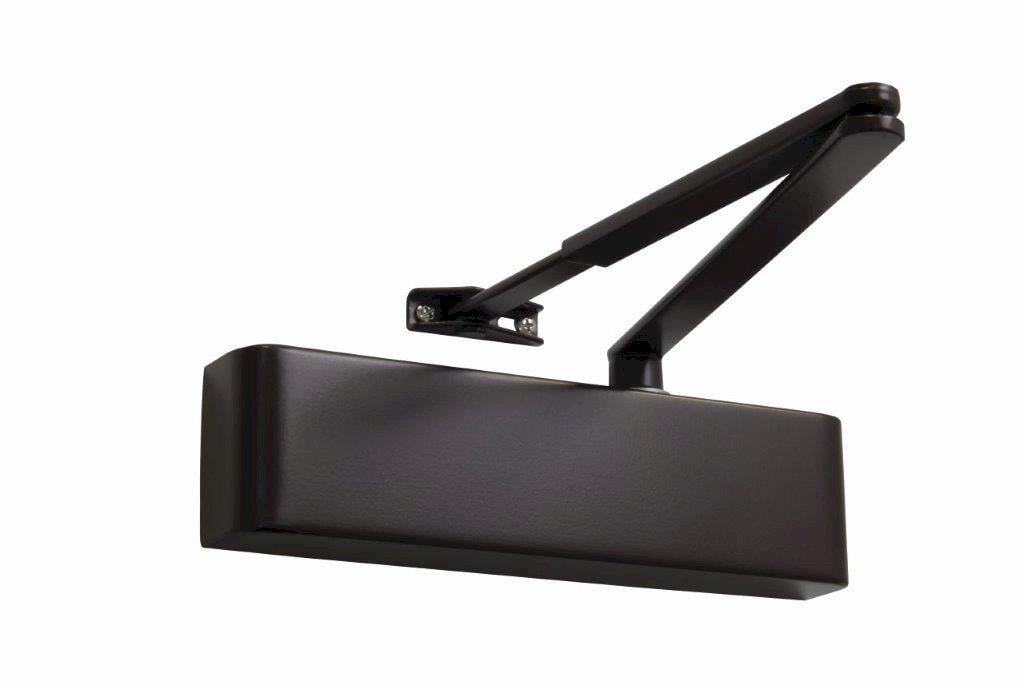Delayed action door closers
The primary function of door closers is to keep doors shut when not in use. This is particularly important on fire doors, which must be fitted with a self-closing device in order to comply with Building Regulations and the Fire Safety Order.
Fire doors should shut within a reasonable time; if they remain open for too long after someone has passed through, then fire safety could be compromised (an open fire door provides no protection!). On the other hand, if they shut too soon they will make it difficult for people to pass through – especially if they are carrying something, pushing a pram, have physical limitations or use a wheelchair.
Approved Document M of the UK Building Regulations says that self-closing devices on manually operated non-powered doors disadvantage many people who have limited upper body strength. Thankfully, there is now a tested-and-proven adaption available for door closers in the form of the Delayed Action function.
What is Delayed Action?
Whereas a standard door closer starts to close as soon as opening pressure is released, the addition of a delayed action stage holds the closing action back for a few seconds. This occurs between the fully opened position and the 70 degrees angle, the point that the ‘closing phase’ starts.
How quickly should a fire door close?
The closure delay is adjustable, to allow for fine-tuning to match site location and situation. For fire safety, the closing delay phase (from 90 degrees open) should be a maximum of 25 seconds, whilst UK accessibility guidance states a minimum of 3 seconds. The USA’s ADA standards state at least 5 seconds should pass between the 90 degrees open position and the final latching stage.
Between these minimum and maximum time delays, it is down to the site’s responsible person to decide on a time delay based on risk assessment and user needs. For example, a doctor’s consultation room might benefit from a door closing quicker for patient privacy, where accessibility needs can be covered by personal assistance. Merton Council (Greater London) provided a guidance of 10 seconds delay for their properties, but again, this might need to be varied for different situations and by individual assessment.
How do delayed action closers work?
Hydraulic technology is used in many advanced door closers to provide several controlled phases, and can be tuned to match the installation.
As a hydraulic door closer is opened, the enclosed oil passes from one chamber to another, with its speed controlled by valves. When the door is fully opened, the closure delay chamber is full of oil and its passage through to the next control valve is restricted by the out-valve. This is the valve that you adjust (with the use of a hex tool) to adjust the delay time. The door usually starts to close when released, then holds back whilst its hydraulic pressure releases.
Where is delayed action not recommended or needed?
There are some situations where another type of door closer would be recommended. In circulation and escape corridors, an electromagnetic door-closing device is best. These allow the door to remain open until a power cut or fire alarm triggers them to release, at which point the door closer mechanism shuts the door.

The Rutland RESPONDER24 is an electromagnetic door closer that has a swing-free mode in addition to the usual hold-open mode. When set to swing-free, the door behaves like it hasn’t got a door closer attached, making it ideal for care homes, and fire-alarmed offices where it’s desirable to have the door stay open. Like other electromagnetic door holders/closers, it functions as a normal closing device when the connected fire alarm is activated.
Do all door closers have a delayed action function?
No, a door closer can be compliant with BS EN 1154 (door closers), and the complete door tested to BS EN 1634 (fire doors) without having a delayed action function.
Delayed closing is aimed at accessibility and day to day usability, so ask your hardware supplier particularly about Rutland delayed action closers. Rutland closing devices that have delayed action also come with Back Check function as standard, these include:
Popular Adjustable Delayed Action Closers:
Medium-duty Overhead Door Closer, IFCC Approved (TS.4204DABC.SRFB)

Certifire and IFCC Approved Closer (TS.5204) Shown here without cover plate

EN1154 Power size 5, IFCC & Certifire approved. Shown here in Dk Bronze

Request a call back
Leave us your contact details and we will call you back for a free consultation about your requirements.

